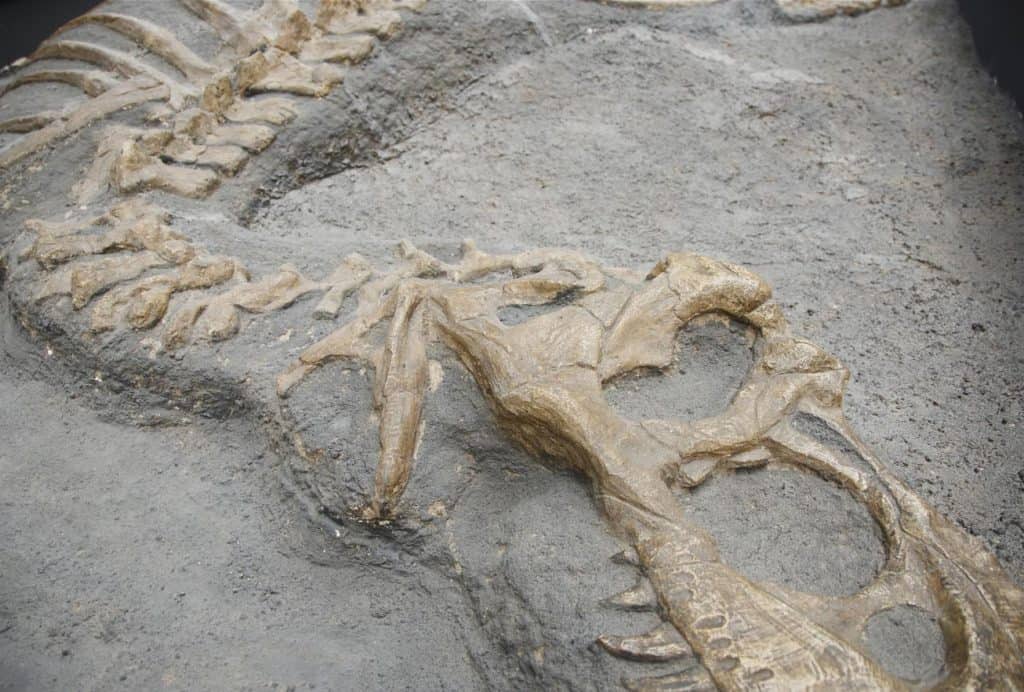Children and adults alike are fascinated by dinosaurs. From action movies to toys to trips to the natural history museum, dinosaurs capture and keep our attention.
But what about all of the science of dinosaurs that we learned as children? If dinosaurs are millions of years old and have evolved into modern species of birds and reptiles, how do we reconcile them with the Bible? How do Christians make sense of dinosaurs?
Christians, like most people, believe that dinosaurs once existed but are now extinct. However, Christians examining the fossil evidence in light of scripture, reach different conclusions about when the dinosaurs lived and how they died.

Before We Begin
If you have not yet read our examination of the theory of evolution, I encourage you to do so now, as that entry elaborates on key concepts that are necessary for forming a Biblical understanding of dinosaurs. For those of you who are familiar with our prior discussion of evolution, I offer the following summaries as a matter of review:
- Although macro-evolution (the common ancestry of all living things) is not supported by the Bible, micro-evolution (adaptation and variation within a closed group of organisms) is Biblically sound and enriches our understanding of natural history.
- Genesis refers to these closed groups of organisms as kinds. Kinds are distinct from the modern classification of species, which describe further variations within animal kinds.
- Facts (such as the existence of dinosaur fossils or their appearance in certain rock layers) are distinct from conclusions about unobserved past events (such as how different rock layers formed or when the fossils were buried). As Bible-believing Christians we interpret the same facts that secular scientists do, but using a different worldview.
We will be relying on this framework as we explore, in question-and-answer format, common questions that are posed by Christians seeking to understand dinosaurs Biblically, or that are posed to Christians by adherents to secular interpretations of scientific data.
Did Dinosaurs Actually Exist?
The plain answer provided by both the Bible and the fossil record is ‘yes.’ (Some well-meaning, but ill-informed Christians have promoted the idea that dinosaurs are a hoax. But their arguments do not stand up to the scrutiny of scripture, nor are they consistent with the extensive fossil record).
Since the nineteenth century, dinosaur fossils have been discovered on every continent, and new discoveries continue into the twenty-first century. And though the term ‘dinosaur’ is a relatively recent development, with English language origins, the Bible describes creatures that are best explained as dinosaurs using the language of its day.
Leviathan
Both the prophet Isaiah (27:1) and the psalmists (74:13-14, 104:26) refer to the size of a sea creature called leviathan as evidence of the grandeur of God. But the richest description of this beast is found in Job 41, where we read an entire chapter of details about the leviathan.
God, speaking to Job, presents the leviathan as a sea creature (vs 1, 31-32) that is too large to be tamed or overpowered (vs 5, 9). Physically, we read that leviathan has limbs (v 12), rows of teeth (v 14), scales (v 15), hot breath (vs 18-21), a strong neck (v 22), and a solid chest and underbelly (vs 24, 30).
Attempts have been made to dismiss the leviathan as a whale, shark, or even a crocodile. But each of these creatures fails on more than one of these descriptors, requiring a great deal of poetic license to reconcile any modern creature with the beast of Job 41.
Behemoth
Leviathan’s land-dwelling counterpart is the mighty behemoth. Introduced in Job 40 (immediately preceding the introduction of leviathan), the behemoth has been interpreted as a number of land mammals, most commonly an elephant or a hippopotamus. But as with leviathan, we read that God’s description of behemoth is not consistent with any modern animals.
God describes the behemoth as a grass eater (v 15) with strong abdominal and torso muscles (v 16), a tail resembling a thick tree trunk (v 17), and sturdy thighs (v 17). He further reveals that the behemoth feeds on the grass of the hills (v 20), but finds comfort in the marsh (v 21-22).
Putting all of this detail together, the creature that most readily comes into focus is not an elephant or a hippo, but a sauropod (brontosaurus and related dinosaurs).
It is worth noting also, that these detailed descriptions of dinosaurs are found in the oldest book of the Bible. Job’s long lifespan, his story’s silence regarding Israel and the law, and the unique linguistics of the book all indicate that Job lived during, or shortly before, the time of Abraham.
On a timeline of the Bible, this places Job’s story as proximate to the post-flood world as any other Biblical narrative with the exception of the Tower of Babel. This proximity explains why dinosaurs are detailed in Job, but sparsely mentioned elsewhere, leading us to our next question…
When Did Dinosaurs Live?
Secular science teaches that dinosaurs preceded humans by millions of years. The traditional timeline is formulated by dating strata (layers) comparatively, and by radiometric methods. (Both dating methods rely on flawed calibration techniques which are beyond the scope of this article).
However, the Bible says that sea creatures and birds were created on the fifth creation day, and land creatures and humans were created the following day. Therefore dinosaurs and humans necessarily coexisted.
This is further evidenced by the wording of Job 40 and 41. In these chapters, God speaks of both creatures in the present tense, inviting Job to look at the behemoth (v 40:15), and calling leviathan a creature without equal (v 41:33). Job 40:15 further emphasizes that God made behemoth along with humans.
The Appearance of Age
It is the mainstream timeline, coupled with previously mentioned fossil dating methods, that assigns ancient ages to the dinosaurs. However, studies of recent events (for example, the 1980 eruption of Mt. Saint Helens) and their aftermath have shown that both the process of fossilization and the formation of rock layers occur more rapidly than we had previously thought.
One fact that gives dinosaurs the appearance of age is that their fossils are generally found in lower strata than those of mammals and humans. However, creation-based flood geology suggests that the strata represent the order of burial of different groups of animals according to their capacity to withstand the onslaught and/or retreat (temporarily) to higher elevations. And speaking of the flood…
Were Dinosaurs on the Ark?
Since dinosaurs lived contemporaneously with humans from the creation of the world until their extinction, they would have necessarily been included among the inhabitants of Noah’s ark. The book of Job, as we discussed, testifies to the post-flood existence of dinosaurs. And Genesis 6:19 says that God commanded Noah to take two of each kind of animal onto the ark. Three verses later, we read that Noah did everything just as God commanded (v 22).
But there are hundreds of different dinosaurs, and many of them are huge. How did Noah make room for all of them? Remembering that Noah gathered kinds (not species) of animals, the number of dinosaurs Noah had to house was comparatively small. While paleontologists have classified several hundred species of dinosaurs, those species represent only a few dozen different kinds. So Noah had fewer than 100 total dinosaurs on the ark.
It is also useful to take a moment to consider what we know about reptiles. Most of us know that reptiles shed their skin. But did you know that this happens because they never stop growing? Additionally, some reptiles also have exceptionally long lifespans (our zoos are homes to tortoises that are older than every person alive today).
Juvenile and adolescent representatives of various dinosaur kinds were likely no larger than cows or horses. However, an ever-growing dinosaur that lived to an advanced age in the food-rich, favorable, pre-flood climate certainly could have reached the size evidenced by our fossil discoveries. Unfortunately for the dinosaurs, that pre-flood climate didn’t last…
How Did the Dinosaurs Become Extinct?
We know from scripture that land dinosaurs were no longer observed by the time of the patriarchs, and even the sea-dwelling leviathan is not heard from after the exile. And apart from a few ancient dragon legends, we don’t read of living dinosaurs in the literature of the past 3500 years. Nor have we encountered them in our modern explorations of the earth’s surface. So where did they go?
After exiting the ark, dinosaurs probably struggled to thrive. Their food sources were depleted, and dinosaurs would have made viable prey for both humans and carnivorous mammals. Add to this the prevailing flood-geology models, which demonstrate that the flood and its aftermath produced an ice age that lasted several centuries. (Incidentally, Job, unlike other books of the Bible, makes regular use of winter imagery).
After the flood, the dinosaurs were simply not suited to last in a hostile environment populated by new natural enemies.
Conclusion
So even though dinosaurs are no longer with us, we can still learn much from them. When we trust God’s word to guide our understanding, we see exactly how dinosaurs played a role in the earliest moments of history and scripture, how they testify to God’s awesome creative power, and how they substantiate the cataclysmic nature of Noah’s flood.





